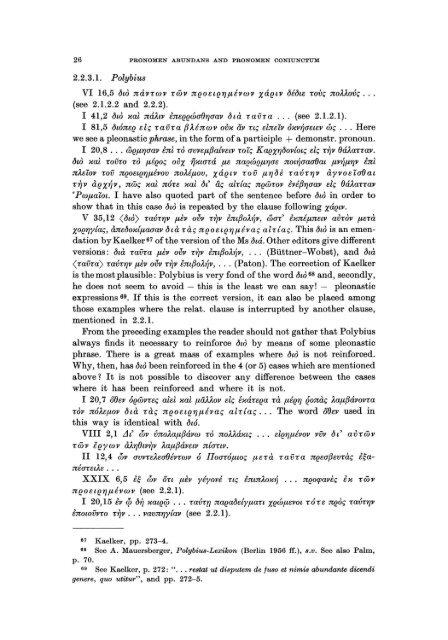Pronomen Abundans and Pronomen Coniunctum. A ... - DWC
Pronomen Abundans and Pronomen Coniunctum. A ... - DWC
Pronomen Abundans and Pronomen Coniunctum. A ... - DWC
You also want an ePaper? Increase the reach of your titles
YUMPU automatically turns print PDFs into web optimized ePapers that Google loves.
26 PRONOMEN ABUNDANS AND PRONOMEN CONIUNCTUM<br />
2.2.3.1. JDolybius<br />
VI 16,5 bUl nánwv nov n(!ost(!'fJflévwv Xá(!tV bibts rovç noÀÀovç . ..<br />
(see 2.1.2.2 <strong>and</strong> 2.2.2).<br />
I 41,2 bLo ~at náÀw èns(!(!wa()'fJaav btà ravra . .. (see 2.1.2.1).<br />
I 81,5 bLóns(! elç 7:aV7:a f3Àénwv ov~ av uç elnûv o~v~aetsv wç . .. Here<br />
we see a pleonastic phrase, in the form of a participle + demonstr. pronoun.<br />
I 20,8 ... w(!fl'fJaav ènt 7:0 avvsflf3a{vetv 7:0lÇ Ka(!X'fJbov{otç elç 7:~V ()áÀanav.<br />
bLo ~ai 7:0V7:0 7:0 flé(!oç OVX ij~tará flS naf!Wf!flYJas not~aa(]()at flv~fl'fJv ènt<br />
nÀûov 7:0V n(!ost(!'fJflévov noUflov, Xá(!tv 7:0V fl'fJbè rav7:'fJv àyvoela()at<br />
7:~V à(! X~v, nwç ~ai nóu ~at bt' aç al7:{aç n(!w7:ov èvéf3'fJaav elç ()áÀa7:7:av<br />
'JDwflalOt. I have also quoted part of the sentence before bto in order to<br />
show that in this case bto is repeated by the clause following Xá(!tv.<br />
V 35,12 ( bLo) mV7:'fJv flèv ovv r~v èmf3oÀ~v, wao' è~néflnetv aV7:ov flS7:à<br />
XO(!'fJy{aç, ànsbo~{flaaav b t à 7: à ç n (! ast (! 'fJ fl é va ç a l7: {a ç. This bto is an emendation<br />
by Kaelker 67 of the version of the Ms bLá. Other editors give different<br />
versions: btà mvm flèv ovv 7:~V èmf3oÀ~v, ... (Büttner-Wobst), <strong>and</strong> btà<br />
(mvm) mV7:'fJv flèv oVV r~v èmf3oÀ~v, ... (Paton). The correction of Kaelker<br />
is the most plausible: Polybius is very fond of the word bto 68 <strong>and</strong>, secondly,<br />
he does not seem to avoid - this is the least we can say! - pleonastic<br />
expressions 69. If this is the correct version, it can also be placed among<br />
those examples where the relat. clause is interrupted by another clause,<br />
mentioned in 2.2.1.<br />
From the preceding ex am pIes the reader should not gather that Polybius<br />
always finds it necessary to reinforce bto by means of some pleonastic<br />
phrase. There is a great mass of examples where bto is not reinforced.<br />
Why, then, has bLo been reinforced in the 4 (or 5) cases which are mentioned<br />
above 1 It is not possible to discover any difference between the cases<br />
where it has been reinforced <strong>and</strong> where it is not.<br />
I 20,7 S()sv óewvuç alû Mt fliiÀÀov elç é~áu(!a rà flé(!'fJ IJonàç Àaflf3ávovm<br />
7:0V nÓÀsflov btà 7:àç n(!OSt(!'fJflévaç al7:{aç . .. The word S()sv used in<br />
this way is identical with btó.<br />
VIII 2,1 L1t' WV vnoÀaflf3ávw 7:0 noÀ).á~tç . . . el(!'fJflévov vVv b t' a V 7: W V<br />
7: W v l (! y w V àÀ.'fJ()t~v À.aflf3ávstv n{anv.<br />
II 12,4 WV avv7:eÀ.w()év7:wv Ó II Oa7:ÓflWç fl s 7: à 7: a V 7: a n(!saf3svràç l~anéautÀs<br />
. . .<br />
XXIX 6,5 è~ wv on flèv yéyové uç lmnÀo~~ . .. n(!ocpavèç è~ 7:WV<br />
n(!ost(!'fJflévwv (see 2.2.1).<br />
I 20,15 èv qJ &j ~at(!0 . . . mvrn na(!a&{y flau X(!WflSVOt 7: Ó 7:8 n(!oç rav7:'fJv<br />
ènowVv7:o 7:~v . .. vavn'fJy{av (see 2.2.1).<br />
67 Kaelker, pp. 273-4.<br />
68 See A. Mauersberger, Polybi'!Ul.Lexikon (Berlin 1956 ff.), s.v. See also Palm,<br />
p. 70.<br />
69 See Kaelker , p. 272 : " . .. restat ut disputem de !'!UlO et nimis abundante dicendi<br />
genere, quo utitur", <strong>and</strong> pp. 272-5.
















